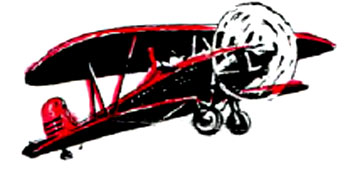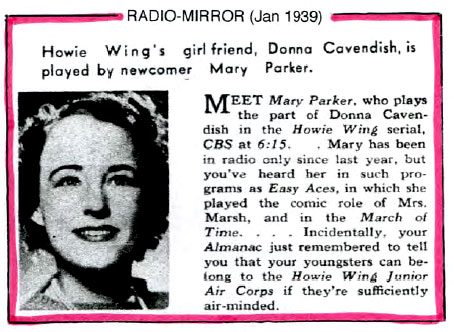|

This story was published in Radio Recall, the journal of the Metropolitan Washington Old-Time Radio Club, published six times per year.
Click here to return to the index of selected articles.
|
|
 UPDATE: HOWIE WING, SIX YEARS LATER UPDATE: HOWIE WING, SIX YEARS LATER
By Kathy Hammel © 2011
(From Radio Recall, February 2012)
In February 2005 I stumbled across three double-sided transcription discs containing 6 episodes of an unknown radio show called Howie Wing. I bought the 16-inch discs on impulse, even though I had no idea what kind of show this was. I did know that they were early radio recordings because of the date (1938) on the label, but other than that, I had no clue. After a mostly uninformative search on the Internet, I was lucky enough to find Jack French. Jack knew that Howie Wing was an obscure 15-minute juvenile serial and that, until my discovery, the OTR community was unaware that any episodes of the show had survived. With the able assistance of several partners in research, we eventually located quite a lot of information and six additional episodes of the show.
One of those additional six episodes was located by Karl Schadow in the Library of Congress. Archie Hunter found another in the Library and Archives Canada. Unfortunately these two episodes are not available for circulation, nor are they easily obtained from the archives. However, the other four are more accessible. The Wisconsin Historical Society in Madison, Wisconsin has two episodes on transcription discs and are ready, willing and able to offer those, for a modest copying fee, to anyone who is interested.
The other two episodes were found on eBay. These episodes were part of a 3rd season of the show, which was only broadcast in Canada. We'd found some information that lead us to believe there may have been a Canada only third season, but until we found this recording we couldn't verify this was so. Eventually we'll have those recordings cleaned up and ready to circulate. With the six episodes we released in 2006 -- all beautifully restored by Jerry Haendiges -- we'll have 8 episodes that will be readily available. We're still looking for more, and the University of Texas apparently has one, but doesn't have the equipment to copy it and hasn't been able to give us any information about it.
Aside from the actual recordings, Karl Schadow found that the J. Walter Thompson archive at Duke University contains all the scripts from the second season, plus the first 10 scripts of Season One. J Walter Thompson was the ad agency that packaged and sold the show for Kellogg's in the US. NW Ayer and Sons handled those tasks for Canada.
The JWT archive also provided some contracts, pay sheets and other information that added quite a lot of information surrounding the show, including the contract for making the transcription discs for distribution.
Over time, I've collected those papers and scripts. The scripts, in general, are pretty exciting. I'm not all that "air minded", but for those who are, there's lots of information about flying and airplanes in general. Even if you're not that interested in how to fly a 1939 aircraft, the scripts are full of action and offer a thrilling read.
I mentioned eBay earlier, and the auction site has been a big help in some regards. Not only did we find the Canadian transcription disc (with two episodes), but we also have found several cereal premiums related to the Howie Wing show. In the US, Corn Flakes was the sponsor, and in its usual style, Kellogg's bombarded the youngsters with many premium offers. Ian Grieve, who is our Australian researcher, not only has collected several of those items, but he found another premium collector who has a fairly extensive collection of Howie Wing memorabilia. Additionally, Ian located an older gentleman who was a Howie Wing fan as a child. An interview with this erstwhile Howie Wing cadet gave us a bit of an insight into the appeal of the show.
In addition to our finds on eBay, and the items shared by Ian's collector acquaintance, we also learned that the Kellogg's archive (Kellogg's sponsored the show) had some other information and promotional materials to share with us. From a very accommodating archivist there, we obtained copies of posters, advertising, premiums and even a copy of a Howie Wing newspaper featuring lots of information about pilots, airplanes and Howie himself.
A few months into our initial research, we were mystified as to why the series ended after only two seasons. The evidence seemed to indicate that Howie Wing was quite popular in both the US and Canada, and Kellogg's even sent the series to Australia to help sell its cereals down under. It took awhile, but we finally located an obituary in the New York Times archive that announced the death of Howie Wing creator, Willfred Gibbs Moore. Moore was felled at the tender age of 42 by a heart attack, leaving a wife and four school age children. He also left hundreds of thousands of fans in three countries wishing for more Howie Wing adventures.
Since the show was apparently quite popular in three countries, we also wondered, why Kellogg's didn't continue it with another writer. We haven't yet gotten a definitive answer to that curiosity, but we've found some clues in some of the papers obtained from the archive at Duke University. As proven by the recording we found on eBay, Kellogg's did try a limited third season in Canada only. William Janney, who played Howie Wing during the better known second season (Oct. 1938-June 1939) was contracted to continue in his role as Howie, though it appears none of the other regulars were similarly invited to continue. The recording of the show, which had initially been done in Chicago (first season), then in New York (second season), now was moved to Toronto. This third season ran from September to November of 1939, with no evidence of further new recordings afterwards.
After listening to the recording we found on eBay, we believe that this truncated attempt at a third season fell short of the quality of the original scripts. My speculation is that Moore may have left some notes, or even a beginning script or two, but another writer was brought in to finish out the storyline. From the two episodes we have, it's my feeling that these shows were inferior.
The show's sad ending, notwithstanding, while it was on air, it was apparently quite successful, if the number of premiums and promotionals we've found are any indication. Aside from the usual array of rings, wings and model airplanes available to young fans of the show, Kellogg's sponsored a series of public airplane related events and contests.
In another exciting turn of events, I was able to locate and talk with Willfred Moore's youngest child. Unfortunately this gentleman was only 5 or 6 years old at the time of his father's passing, so knew very little about his father's radio writing career, but he shared that several of Willfred Moore's children and grandchildren had followed in his footsteps. Not as radio writers, but instead as pilots. Willfred Moore wrote about airplanes and flying so well because he, himself, was an accomplished pilot. Not only did he fly in the Canadian Royal Air Force during World War I, but he also achieved some notoriety as a race pilot afterwards.
Due to his vast knowledge of flying, and especially flying during wartime, Moore scripts were both spine-tingling and educational. Using his considerable inside knowledge, his shows tell young listeners how things work, and also keep them on the edge of their seats through daring escapes and breathtaking maneuvers.
We've discovered through magazine articles and news clippings that Janney probably was not the original Howie. Season one had a different cast, but we're not yet sure who all of them were. We found one small snippet that said Billy Rose and Bill Bouchey were in the cast, but not what roles they were playing. We do not think the "Billy Rose" noted here is the same Billy Rose that was the husband of Fanny Brice (they were going through a divorce at that time). We contacted the Chicago branch of AFTRA to enquire about the William Rose who was one of the first season actors. They were able to tell us that he was registered with them in 1938, and they also did not believe he was the New York showman of the same name. We also learned, again through payroll sheets and news clippings, that at least three different actresses played Howie's gal pal, Donna Cavendish: Audrey McGrath, Betty Weeks and Mary Parker.

The probable reason for the change of cast for the second season is that, initially, Kellogg's was, it appears, giving the show a limited trial before making a firm commitment to it. At about the time they picked up Howie Wing, a Saga of Aviation, to advertise Corn Flakes, The Story Lady show (with Ireene Wicker) which Kellogg's also sponsored, was going off air. They needed a replacement for that very popular show. Looking for something suitable for kids, they contracted, in December 1937, to purchase Howie Wing. That first season was broadcast just in the western states and provinces, starting in Canada on January 31st, and two week later in the United States (February 14, 1938).
We surmise the test was successful, as after a time, the radio schedules reflected that the transcriptions were making their way eastward and the second season was broadcast to all of the US, Canada and Australia. During the second season, Kellogg's also stepped up their advertising and special events. They ran contests to pick which young fans made the best models (and, of course, they offered models that the youngsters could purchase to build). They also set up open houses at different airports where young fans could go for a tour, and arranged discounts to Howie Wing Cadet Aviation Corps club members at local movie theatres that were showing aviation related films.
With as much as we've learned about this once obscure show, we continue to have many more questions. We may never get all the answers, but Ian Grieve, Archie Hunter and I continue keeping an eye out for more information. And there is more coming to light fairly regularly. With people and institutions placing more newspapers, books and other resources on line, we find new references every few months. We also hope to track down more recordings as archives digitize their collections and offering on-line finding aids.
The work of an old-time radio researcher is likely never done, especially for short run shows featuring lesser-known actors. Fortunately we live in the digital age where most archives and libraries are making their collections available online. With the ever-growing resources at hand, we surely will have the pleasure and excitement of new discoveries about Howie Wing and other shows in the near future. All we have to do is keep looking; so far we've not been disappointed.
|